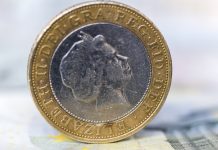UK manufacturing sector contracted in May as Brexit stockpiling halted. The weak figure pulled the pound lower versus the euro. The pound euro exchange rate hit a low of €1.1250.
| What do these figures mean? |
|---|
| When measuring the value of a pair of currencies, one set equals 1 unit and the other shows the current equivalent. As the market moves, the amount will vary from minute to minute. If the euro amount increases in this pairing, it’s positive for the pound. Or, if you were looking at it the other way around:1 EUR = 0.87271 GBPIn this example, €1 is equivalent to approximately £0.87. This measures the euro’s worth versus the British pound. If the sterling number gets larger, it’s good news for the euro. |
UK manufacturing pmi dropped to 49.4, unexpectedly falling into contraction. Analysts had been expecting a reading of 52.5, just a slight move down from April’s 53. 50 is the key level that separates expansion from contraction. Instead the sector experienced its biggest downturn in almost three years as new orders dried up and Brexit stockpiling came to an abrupt end. The contraction doesn’t bode well for economic growth in the second quarter, which is starting to look as if it stalled.
| Why does poor economic data drag on a country’s currency? |
|---|
| Slowing economic indicators point to a slowing economy. Weak economies have weaker currencies because institutions look to reduce investments in countries where growth prospects are low and then transfer money to countries with higher growth prospects. These institutions sell out of their investment and the local currency, thus increasing supply of the currency and pushing down the money’s worth. So, when a country or region has poor economic news, the value of the currency tends to fall. |
The weak manufacturing data comes as UK manufactures say that it would be economic lunacy to leave the European Union without a deal. The latest data is evidence of the fact that investment would remain scarce in the case of a no deal Brexit, hitting the sector and the UK economy. The warnings come as multiple candidates battling to replace Theresa May as Conservative party leader and UK Prime Minister have said that they would push for Brexit on 31st October, with or without a Brexit deal. Fears of the increased possibility of a no deal Brexit are weighing on the pound and could continue to do so for some time yet.
Euro Benefits From Falling Dollar
The euro was broadly in favour on Monday despite some weak economic data. The manufacturing pmi for Germany showed that the sector remained deeply in contraction at 44.3, although this was what analysts had been expecting.
The euro received a boost from a weaker dollar. The euro traders inversely to the dollar and the dollar dropped sharply in the previous session. US manufacturing sector unexpectedly fell into contraction, dipping to the lowest level in almost a decade. Escalating trade tensions between US and China have hit manufacturing sectors are around the globe as fears of a global downturn take hold. Whilst the dollar had previously benefited from its safe haven status, investors now believe the Federal Reserve will cut interest rates. As a result, the dollar fell, boosting the euro.
Today eurozone inflation could serve to pull the euro lower. Analysts are forecasting a heavy decline inflation to just 1.3% in May, down from 1.7% the previous month. Weak inflation and soft manufacturing figures won’t entice the European Central Bank to raise rates soon.
| Why do raised interest rates boost a currency’s value? |
|---|
| Interest rates are key to understanding exchange rate movements. Those who have large sums of money to invest want the highest return on their investments. Higher interest rate environments tend to offer higher yields. So, if the interest rate or at least the interest rate expectation of a country is relatively higher compared to another, then it attracts more foreign capital investment. Large corporations and investors need local currency to invest. More local currency used then boosts the demand of that currency, pushing the value higher. |
This publication is provided for general information purposes only and is not intended to cover every aspect of the topics with which it deals. It is not intended to amount to advice on which you should rely. You must obtain professional or specialist advice before taking, or refraining from, any action on the basis of the content in this publication. The information in this publication does not constitute legal, tax or other professional advice from TransferWise Inc., Currency Live or its affiliates. Prior results do not guarantee a similar outcome. We make no representations, warranties or guarantees, whether express or implied, that the content in the publication is accurate, complete or up to date. Consult our risk warning page for more details.
This article was initially published on TransferWise.com from the same author. The content at Currency Live is the sole opinion of the authors and in no way reflects the views of TransferWise Inc.





